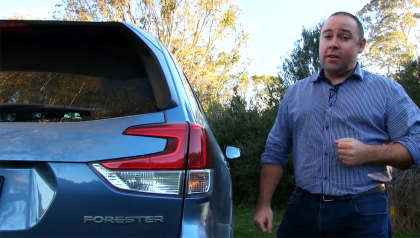The Honda CR-V has been a long-time favourite in the CarsGuide offices, but there’s always been a bit of a caveat hanging over the mid-size SUV range - it all came down to a shortage of active safety technology.
With the 2021 Honda CR-V facelift that has been addressed - to a degree - and in this review we’ll cover off the changes that have been made, from an expansion of the Honda Sensing suite of safety tech, to the styling changes inside and out for the updated model range.
At the end we’ll try and sum up if the Honda CR-V 2021 range update has brought this model back into contention against the likes of the Subaru Forester, Mazda CX-5, VW Tiguan and Toyota RAV4.

Honda CR-V 2021: VTI LX (awd) 5 Seats
| Engine Type | Turbo 4, 1.5L |
|---|---|
| Fuel Type | Unleaded Petrol |
| Fuel Efficiency | 7.4L/100km (combined) |
| Seating | 5 |
| Price From | $30,360 - $36,630 |
| Safety Rating |
|
Does it represent good value for the price? What features does it come with?
7 / 10
As part of the 2021 updated range, the CR-V saw a number of name changes, but there are still seven variants available, ranging from five to seven-seaters, and with front-wheel drive (2WD) or all-wheel drive (AWD). Prices are up across the carryover models by between $2200 and $4500 - read our original pricing story to see why.
Opening the range is the Vi, which carries over as the only model in the range without the turbo engine (any CR-V with VTi as part of its name indicates turbocharging), while it’s also the only CR-V without the Honda Sensing safety suite. More on that in the safety section below.
The prices seen here are the Manufacturer’s List Price, also known as MSRP, RRP or MLP, and don’t include on-road costs. Shop around, we know there will be drive-away deals.
The Vi model lists at $30,490 plus on-road costs (MSRP), which is more expensive than the pre-facelift model, but this version - which has 17-inch alloy wheels and cloth seat trim - now runs a 7.0-inch touchscreen media system with Apple CarPlay and Android Auto, as well as dual-zone climate control. This version also has Bluetooth phone and audio streaming, 2x USB ports, a digital instrument cluster with digital speedometer, and a four speaker sound system. It has halogen headlights and LED daytime running lights, as well as LED tail-lights. There’s a reversing camera fitted, too.

Step up to the VTi for $33,490 (MSRP) and you gain the turbo engine (details below), as well as keyless entry and push-button start, an additional four speakers (eight total), an additional 2x USB ports (four total), a cargo cover, exhaust pipe finishers, adaptive cruise control and the Honda Sensing active safety suite (detailed below).

The VTi 7 is new to the range, and is essentially a more economy-focused version of the old VTi-E7, now costing $35,490 (MSRP). For context, the VTi-E7 used to have leather trim, power driver’s seat adjust and 18-inch alloys. The new VTi 7 costs $1000 more than the old car, misses all of those items (now cloth trim, 17-inch wheels, manual seat adjust) but has the safety suite. It adds third row seats with air vents, plus two additional cup holders and curtain airbag coverage, as well as third-row top tether hooks in the boot floor. It misses a cargo blind, though.
The next model up the pricing tree is the VTi X, which replaces the VTi-S. It is a $35,990 (MSRP) proposition, and adds the safety tech and a hands-free tailgate, as well as auto headlights, auto high beam lights, a leather steering wheel, and from this grade up you get Honda’s LaneWatch side camera system in lieu of a traditional blind-spot monitoring system, and in-built GPS Garmin sat nav. This is the first grade in the range to get 18-inch wheels, plus it has rear parking sensors standard, and front parking sensors, too.

The VTi L AWD is the first grade in the step-up with all-wheel drive. It essentially replaces our previous pick of the range, the VTi-S AWD, but costs more. The VTi L AWD is $40,490 (MSRP), but adds a few goodies over the models below, including leather-appointed seat trim, driver’s seat electric adjustment with two memory settings and heated front seats.
The VTi L7 ($43,490 MSRP) does away with AWD but gains the third-row seating, as well as the good stuff mentioned in the VTi L as well as privacy glass, a large panoramic glass sunroof, LED headlights and LED fog lights, and a wireless phone charger. It also gets auto wipers and roof rails, plus steering wheel paddle shifters.
The top-of-the-range VTi LX AWD is a pretty pricey offering, at $47,490 (MSRP). In fact, that’s $3200 more than it used to cost. It’s a five-seater, and over the VTi L7 adds items like heated door mirrors, auto up/down windows for all four doors, an auto-dimming rearview mirror, electric front passenger seat adjustment, a leather-wrapped shift knob, DAB digital radio, and it gets 19-inch alloy wheels.

It’s fair to say the grades are pretty confusing, but thankfully Honda doesn’t charge extra for the colours available in the CR-V range. There are two new hues available - Ignite Red metallic and Cosmic Blue metallic - and the selection on offer does vary based on the grade.
Is there anything interesting about its design?
8 / 10
The styling changes are pretty minimal compared to the pre-facelift model. Well, that’s certainly the case if you simply glance at the 2021 Honda CR-V.
But look a little closer and you realise there have actually been quite a few nips and tucks here and there, with the overall effect being subtle but worthwhile in terms of visual upgrades.

The front end has seen the adoption of a new bumper design that almost looks like there’s a silver moustache across the lower part of the bumper, and above it there’s a new blacked out grille treatment at the front, too.
In profile you’ll notice new alloy wheel designs - ranging from 17s on the base car through to 19s on the top-spec version - but otherwise the side-on view is pretty similar, aside from a bit of garnish work in the lower parts of the doors.

At the rear there are similar minor bumper changes with added accents at the bottom of the bar, and now there are darker tinted tail-lights and a dark chrome tailgate garnish, too. Models bearing the VTi prefix also get new shaped exhaust tips, which look a little more substantial than before.
Inside, there aren’t many big changes, but that’s no bad thing. The CR-V’s cabin has always been one of the most practical in the class, and that certainly hasn’t changed with this update. Check out the interior pictures below to see for yourself.


How practical is the space inside?
9 / 10
One of the main reasons we’ve always been fans of the current gen Honda CR-V at CarsGuide is its practical cabin. It is, arguably, the best midsize SUV for young families in this part of the market.
That’s because it prioritises space and comfort, practicality and cabin smarts over things like excitement and wow factor.
Sure, there’s a bit of a problem with that - rivals like the RAV4 prove you can do both things well. But the CR-V is unapologetically pleasant and well sorted in terms of practicality. It’s truly the pragmatic choice in this part of the market.
Up front there’s a clever centre console section that has been rethought for this update, and now scores easier-to-access USB ports, and in grades equipped with it, a wireless phone charger. There are still good sized cup holders, and the removable tray section that allows you to configure the console storage how you need it - see how much I fit in there in the video above.

There are also good sized door pockets with bottle holders, and a reasonable glovebox, too. It’s very cleverly designed, and the materials are good, too - the VTi LX model I drove had soft trim on the doors and dash, plus the leather seats are comfortable and offer good adjustment. I’ve driven CR-Vs with cloth seat trim too, and the quality is always top notch.
The shortfalls come in the ‘ooooh’ department. The CR-V still runs a small 7.0-inch media screen - some rivals have much larger displays - and while it does have Apple CarPlay and Android Auto, plus a volume knob, it’s still a bit fidgety in terms of the operation. And it’s slow to react at times, too.
Plus, while there is a climate button and fan speed button, as well as dials for the temperature settings, you still have to go through the screen to control whether the air conditioner is on or off, and also which ventilation is active. Odd.
In the back seat, there’s a really neat trick. The doors open up to almost 90 degrees, meaning parents loading their kids into child seats will be able to access the back row a lot easier than some rivals (we’re looking at you, Mr RAV4, with your narrow-hinged doors). Indeed, the apertures are huge, meaning access for people of all ages is pretty easy.
And the space in the second row is excellent, too. There is easily enough space for someone my size (182cm / 6’0”) to sit behind their own driving position with ample knee room, toe space and shoulder room to be comfortable. Only the head room is questionable if you get a CR-V with a sunroof, and even then, it’s not terrible.

If you do have kids, there are ISOFIX child seat anchor points in the outboard seats, and three top tether attachment points - but unlike most rivals, they actually mount in the ceiling above the boot, not the back of the second-row seat. Choose a seven-seater and you have the same issue, but the third-row seats add a pair of top-tether points mounted into the very back boot floor.

The seven-seat versions of the CR-V have a sliding second-row seat, which makes head room even tighter. The five-seat CR-Vs have a 60:40 split fold second row. All models have a flip down armrest and cupholders fitted in the second row, plus door pockets large enough for big bottles, and map pockets on the front seat backs.
-cut.jpg)
I tested the seven-seat CR-V pre-facelift, and found the third row space to be best left to smaller occupants. If you choose a three-row CR-V, you get rear row air vents and cupholders, too.
.JPG)
The boot space on offer for the CR-V also depends on the seating configuration. If you choose a five-seater like the VTi LX model here, you get a cargo capacity of 522 litres (VDA). Get the seven-seater, and the five-seats-up measurement is 50L less (472L VDA), while with all three rows of seats in use, there’s 150L (VDA) of boot space.

If that’s not enough boot capacity - and it won't be if you’re heading away with all seven seats in use - you might want to consider checking out the accessories catalogue for roof rails, roof racks or a roof cargo box.

Happily, though, all CR-Vs come with a hidden full-size alloy spare wheel under the boot floor.

What are the key stats for the engine and transmission?
7 / 10
There are two engines available in the Honda CR-V range - the one fitted to the base model Vi, and the one fitted to all models that have VTi as part of their badge.
The Vi’s engine is a 2.0-litre four-cylinder petrol engine producing 113kW of power (at 6500rpm) and 189Nm of torque (at 4300rpm). The transmission for the Vi is a continuously variable transmission (CVT) automatic, and it’s front-wheel drive (2WD/FWD) only.
The VTi models in the range get a turbo motor. According to Honda, that’s what the ‘T’ now stands for in CR-V land.

That engine is a 1.5-litre four-cylinder turbo-petrol unit producing 140kW of power (at 5600rpm) and 240Nm of torque (from 2000-5000rpm). It’s available mated to a CVT auto gearbox, and the choice of FWD/2WD or all-wheel drive (AWD).
If you’re after a diesel, hybrid or plug-in hybrid version of the CR-V, you’re out of luck. There’s no EV / electric model either. It’s purely a petrol affair here.
Towing capacity for the CR-V is pegged at 600kg for unbraked trailers, while the braked towing capacity is 1000kg for the seven-seat versions and 1500kg for five-seat models.
How much fuel does it consume?
7 / 10
The combined cycle fuel consumption varies depending on the model you choose in the CR-V range.
The non-turbo 2.0L engine in the Vi is the thirsty one, using a claimed 7.6 litres per 100 kilometres.
The VTi engine’s fuel consumption varies depending on the model, seating and drivetrain (2WD or AWD). The entry grade VTi FWD uses a claimed 7.0L/100km, while the VTi 7, VTi X and VTi L7 use 7.3L/100km, and the VTi L AWD and VTi LX AWD claim 7.4L/100km.

On test in the top-spec VTi LX AWD - across a mix of urban, highway and open road driving - we saw an at the pump fuel use return of 10.3L/100km.
All CR-V models come with a 57 litre fuel tank capacity. Even the turbo models can run on 91RON regular unleaded, too.

What's it like to drive?
8 / 10
Fit for purpose. That summaries the drive experience of the Honda CR-V 2021 model, which is unashamedly a family car and drives how a family car should.
That is to say it’s not as exciting or powerful as some rivals. If you’re after driving thrills, you maybe shouldn’t even be looking in this segment, certainly not at this price point anyway. But I will say this - on balance, the CR-V offers a competitive midsize SUV drive experience if you value comfort and easy driving overall.

The CR-V’s turbo engine offers decent pulling power across a good span of revs, and while we often criticise CVT automatic transmissions, the auto used here makes good use of the turbo engine’s torque band, meaning it accelerates smoothly enough and responds with enough urgency when you plant your foot. There’s a very slight lag to contend with during rolling acceleration, but it takes off from a standstill pretty well.
.JPG)
The engine is a little vocal under hard acceleration, but generally the CR-V is quiet, refined and pleasant - there’s not too much road noise (even on the 19-inch wheels of the VTi LX AWD), and there’s minimal wind roar, too.
.JPG)
The steering in the CR-V has always been a bit of a highlight - it has a really quick action that is well weighted and offers good accuracy, while not necessarily giving the driver a lot of feel and feedback. It’s great when you’re parking, because the wheel takes very little effort to turn.

There have been changes to the suspension for the 2021 Honda CR-V, but you’d be hard pressed to pick them - it still rides comfortable and hardly ever feels upset by bumps (only sharp edges at lower speeds cause some clunkiness, and that’s based on the drive in the VTi LX AWD with its large 19-inch wheels and low profile Michelin Latitude Sport 255/55/19 tyres).
.JPG)
Don’t get me wrong - the suspension is set for softness as a priority, so there is some body roll to contend with in corners. For family buyers, the drive experience is good, though anyone looking for a fun drive might be better served considering a Tiguan or RAV4.
[product:3d]{"url":"https%3A%2F%2Fcarsguide.captur3d.io%2Fview%2Fhonda-2%2Fhonda-cr-v-camping","headline":"Explore the Honda CR-V in 3D.","subtext":"Check out the CR-V on a camping adventure."}[/product]
Warranty & Safety Rating
What safety equipment is fitted? What safety rating?
7 / 10
The Honda CR-V was awarded a five-star ANCAP crash test rating in 2017, but given the rapid changes in protocols from the safety watchdog, it wouldn’t score that today - even with the broader application of the Honda Sensing suite of safety tech.
Models from the VTi variant up now score the Honda Sensing suite of active safety technologies. Previously, only five-seat AWD models were eligible for this tech, but now there’s been some level of democratisation of the safety spec, with 2WD models and seven seat CR-Vs now getting the tech.
_0.JPG)
All CR-Vs with VTi as part of their name now get forward collision mitigation (FCW) with collision mitigation braking system (CMBS), which combines into a form of autonomous emergency braking (AEB) that operates at speeds above 5km/h and can detect pedestrians, too. The lane keeping assistance (LKA) system can help keep in the centre of the lane by using a camera to monitor road markings - it works between 72km/h and 180km/h. There’s also a lane departure warning (LDW) system that can vibrate the steering wheel if it thinks you’re leaving your lane, before steering the car back (mildly) and applying brakes - it works at the same speeds as the LKA system.
There’s also adaptive cruise control that works between 30km/h and 180km/h, but at speeds below 30km/h the brand’s ‘Low Speed Follow’ system will accelerate and brake while keeping a safe distance. It won’t automatically resume if you come to a complete stop, though.
While the list of safety gear is an improvement for the CR-V range more broadly, this upgrade still leaves it well and truly behind the best in the class for safety tech. It is not designed to include cyclist detection, and it misses out on a traditional blind spot monitoring system - instead, only some models in the line-up get the LaneWatch camera system (VTi X and above) that simply isn’t as good as a real blind-spot system. There’s also no rear cross-traffic alert, and no rear AEB. There is no surround view / 360 degree camera available on any grade, either.
-cut.jpg)
The fact Honda hasn’t taken the opportunity to fit the safety tech system to all models in the CR-V range is both befuddling and disappointing. You were so close, Honda Australia. So close.
At the very least, the CR-V has an array of airbags (dual front, front side and full length curtain) and yes, the seven seat models get proper third-row airbag coverage, too.
What does it cost to own? What warranty is offered?
7 / 10
The Honda CR-V is backed by the brand’s five-year/unlimited kilometre warranty, which is par for the course in the segment.
There is the option of an extended warranty plan out to seven years, which also bundles in roadside assistance for that period - but you have to pay for it. You don’t if you buy a Kia or SsangYong.

Honda asks for owners to have their cars serviced every 12 months/10,000km, which is shorter intervals than many rivals (annually or 15,000km). But the service costs are low, pegged at $312 per visit for the first 10 years/100,000km of ownership - just note, that figure doesn’t include some consumables.
Worried about Honda CR-V problems - be it reliability, issues, complaints, transmission problems or engine concerns? Head to our Honda CR-V problems page.
Verdict
The updated Honda CR-V range is certainly an improvement on the model it replaces, with the wider spread of safety tech now making it a more viable option for more potential customers.
But the fact of the matter is that the 2021 Honda CR-V update still doesn’t go far enough in expanding the safety spec of the midsize SUV, and multiple competitors better it in many ways. And if you’re a family buyer, then safety is surely a high priority, right? Well, if that’s you, maybe consider those aforementioned rivals - the Toyota RAV4, Mazda CX-5, VW Tiguan and Subaru Forester - all of which best the CR-V in some way or another.
If you don’t think you need those additional safety items, or you’re just sold on the practical and thoughtful cabin design of the CR-V, there’s certainly something to be said for the 2021 version over the earlier models. And in this range, I’d say the pick would be the VTi 7 if you need three rows, or the VTi for those only needing five seats.
Pricing Guides



.jpg)
.jpg)
.jpg)
.jpg)









































 copy.png)



















.jpg)




Comments